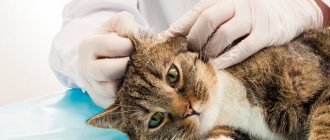8795Pavel
A cat, like a person or dog, has a normal temperature. Only in the mustachioed pet it is significantly higher than in humans. So, for an adult cat the norm is 37.8-39.2 degrees, and for a young animal 38.3-39.7 degrees. However, a cat may have a low or high temperature. Today we will talk specifically about low body temperature, which is also called hypothermia. It is typical mainly for small kittens and older individuals.
Experts divide hypothermia into 3 types:
- mild – body temperature fluctuates between 32-35 degrees;
- moderate – 28-32;
- deep - below 28 degrees.
© shutterstock
Normal temperature for a cat
The temperature in cats, unlike in humans, is considered normal in the range from 37.8 to 39 degrees.
Higher values indicate a pathological process or overheating of the body. An increase in temperature cannot be ignored, as the cause may be a serious pathology. Normally, a cat’s body is designed in such a way that excess heat is eliminated naturally through the skin and respiratory system. If the pet is sick, then this process of thermoregulation is disrupted.
A cat's normal body temperature is ensured by the body's natural thermoregulation.
It is important to know that cats' body temperature is higher than that of humans. 37.8 is the optimal temperature for your pet.
Cat owners must know that the optimal temperature for their pet ranges from 37.5-39 degrees, which is much higher than that of humans. It is important to note that different breeds have different indicators as the norm. For example, for a sphinx the norm is 40 degrees, but for others this is already a signal of pathology.
A thermometer is the most reliable way to measure a cat's temperature.
And just like people, cats often suffer from fever. As a result, the question arises, how do you know if the temperature is elevated? The methods that people use are not suitable for this. If you feel your pet's forehead, you will not be able to judge the presence/absence of temperature. Most people are accustomed to determining the condition of cats by their nose. If it is damp and cool, then everything is fine, but when it is hot and dry, you should sound the alarm.
The most proven and reliable method of determining temperature is using a thermometer. It is placed either in the rectum or ear canal. Don’t be afraid of the animal’s reaction, naturally, whims and manifestations of character will begin, but despite this,!
If your pet's body temperature rises, there is no need to take risks. Contact your veterinarian as soon as possible.
In addition, there are certain symptoms that signal this pathology. With their help you will know whether you need to measure your temperature or not. If the result shows 39.4 degrees Celsius, seek help from a veterinarian.
Symptoms
If your cat has become lethargic and sleepy, this may be due to an increase in its body temperature.
- Lack of usual appetite.
- Apathy, .
- Presence of tremor, trembling.
- The cat has a rapid heartbeat.
- Happening.
- Strange behavior, state of shock.
If these symptoms occur, you cannot do without the help of a veterinarian.
If your pet suffers from low body temperature, then it is necessary, first of all, to warm it up. To do this you should:
- if the cat is outside, bring it into the house;
- if the animal gets wet from rain or snow, it is dried with a hairdryer and wrapped in a towel;
- wrap in a warm blanket and place a heating pad on it, heated to 39 degrees;
- the mustachioed pet is given warm milk or warm broth;
- periodically measure the temperature, it must be under control;
- if the temperature begins to return to normal, then the cat needs to be fed a little.
When normal internal temperature in cats is not restored, you should definitely call a doctor or take your pet to him.
Take the cat to the clinic immediately if its temperature drops to 36 degrees and continues to drop rapidly.
The veterinarian will carry out a full examination of the animal and will be sure to correctly diagnose the cause of the low temperature, and will also help treat your pet.
The veterinary clinic can:
- Give your pet a warm enema.
- Place a dropper with a warming solution.
Kittens have an imperfect thermoregulation system. Their temperature is usually higher than that of adults. This is how the baby’s body reacts to the outside world, starting a fight against the most harmless phenomena, sometimes without any reason. In addition, a slightly elevated kitten’s temperature is (just in case) protection against hypothermia. His body is not yet completely “sure” that the world around him can be “trusted”.
The norm for small kittens is a temperature of 39 - 39.5 degrees, but it is important to know individual indicators. Only at 2–3 months do cats develop a constant temperature.
The easiest way to measure temperature is with household thermometers. There are several types of them: electronic, alcohol, mercury thermometer. It is much more convenient to use new devices, as they provide results faster. The chances of breaking them or breaking them are much less. However, due to the high cost, many people prefer proven old thermometers.
If your cat becomes lethargic or begins to behave strangely, be sure to take its temperature. For this you will need:
- Paper towel.
- Alcohol.
- Thermometer (it is better if it is a special rectal one).
- Lubricant (mineral oil or Vaseline).
- Something tasty (for the cat).
- The electronic thermometer must be turned on. Shake the mercury so that the column of mercury falls.
- Coat the tip of the thermometer with grease.
- Place the cat on its side and press the other side with your elbow. You can wrap the animal in a sheet, blanket or towel so that it does not scratch or bite anyone during the procedure.
- With one hand, gently lift the tail.
- Scroll the thermometer slowly and insert it into the back hole with one hand.
- When using a mercury thermometer, time it for 2 minutes; when using an electronic thermometer, wait for the signal.
- Take out a thermometer, moisten a paper towel with alcohol and wipe it.
- Determine the value of the thermometer.
- Reward your cat with something tasty.
A more gentle way to measure your cat's temperature is to use an infrared ear thermometer. It should be 37.8 - 39.4 degrees. The action of such a thermometer is based on obtaining data on the temperature of the blood that flows to the brain. It actually measures the heat impulses that come from the eardrum.
An increase in temperature can be indicated if the cat's fur becomes warm, as if it had recently been lying in the sun, and its ears become warmer than usual.
Some people believe that you can determine a cat's body temperature by feeling its nose (wet or not). It is not true. A dry nose can be due to many reasons (temporarily). If your cat has a warm, dry nose, this is just a reason to monitor its condition more closely.
Both low and high temperatures indicate an illness in the cat. In this case, she needs to be shown to a veterinarian.
Hypothermia Treatment Methods
First aid should be aimed at increasing the animal’s body temperature. The cat must be covered with hot water bottles. If this does not help, the pet should be taken to a veterinary hospital immediately.
The doctor will take the following measures:
- examine the patient;
- will administer intravenous infusion with warm solutions;
- relieves the symptoms of the disease that led to hypothermia;
- prescribe oxygen therapy;
- will carry out constant monitoring of body temperature until the animal’s condition stabilizes.
What temperature is considered normal for cats?
In cats, a decrease in temperature is caused by several reasons. This condition appears due to diseases of the cardiovascular and nervous systems, renal failure, prolonged operations, and injuries. One of the main reasons is hypothermia of the cat's body or blood loss.
- The cat is trying to find a warm place.
- Trembling appears.
- Oppression.
- Paleness of the skin and mucous membranes.
- The fur is tousled.
- Curls up into a ball.
- Wrap the cat in a blanket, place it in a warm place, and cover it with heating pads.
- Provide warm drink.
- If the temperature is very low, it is dangerous. Here you will need the help of a veterinarian.
We suggest you read: How many times a day to feed a cat nutrition rules
The thermoregulation of a cat's body can be disrupted and be non-infectious and infectious in nature. At the same time, there is an increase in temperature.
- Medication. Appears when substances are introduced into the body that stimulate thermoregulation centers in the brain.
- Salt origin. Salts accumulate in the body, which lead to the breakdown of tissues and proteins.
- Protein origin. When necrotic processes occur in the body, protein breakdown products appear.
An increase in temperature may be accompanied by a fever. She happens
- Febrile (up to 2 degrees above normal).
- Hyperpyretic (up to 3 degrees above normal).
- Subfebrile (1 degree above normal).
The increase in temperature may increase slightly and is normal (of a physiological nature):
- During pregnancy.
- During drinking and eating.
- After physical activity.
Only additional laboratory tests (X-rays, urine and blood tests, ultrasound) will help accurately determine the diagnosis.
- Increased heart rate.
- Rapid and deep breathing.
- Dehydration of the body.
- Oppression.
- The third eyelid may cover the eye.
- Refusal to eat.
If the temperature is elevated, especially significantly, you should definitely take your pet to the veterinarian. During high temperatures, there is a danger of dehydration, and this can end in disaster.
If the thermometer readings are slightly elevated, you should not knock it down, because this process indicates the activation of the body’s defenses.
In order to bring down a cat's temperature, you need to do the following:
- Provide the animal with cool water to drink.
- Lightly moisten the cat's fur.
- Apply ice to the area of the inner thighs and neck.
It is not advisable to give antipyretic drugs to your cat; you can try to bring down the temperature using the methods indicated above and call a veterinarian as quickly as possible.
Important: A cat’s body temperature is not an independent symptom of illness. Very often, the thermometer readings may be within normal limits, but other signs create the clinical picture of the disease. If your pet has a fever combined with other symptoms: lethargy, vomiting, impaired diuresis, refusal to feed, then in these cases you should definitely consult a veterinarian.
Health to you and your furry pets.
We all love our pets and worry when something is wrong with them. One of the symptoms of serious illness in an animal may be low body temperature. The thermoregulation center is located in the brain, or more precisely in one of the parts of the medulla oblongata (hypothalamus).
The normal body temperature of an adult cat is recorded in the range of 37.8 - 39.2 °C, for kittens - from 38.3 to 39.7 °C.
The scientific name for a condition characterized by a drop in body temperature is hypothermia.
There are three stages of the disease:
- Mild (body temperature 32 – 35°C);
- Moderate (temperature drops to 28 – 32°C);
- Deep (body temperature below 28°C).
A decrease in body temperature leads to centralization of blood circulation. Blood rushes to the brain and heart, protecting them first, and peripheral blood flow decreases at this time. Metabolic processes slow down and the body's defense mechanisms turn on (muscle tremors, fur fluffs up, breathing slows down).
The acid-base ratio in the blood changes, hypercapnia develops (increased carbon dioxide content), then interstitial and interstitial fluid rushes into the alveoli. In this case, the process of cellular respiration is disrupted, and the supply of oxygen to the tissues is insufficient. Against the background of pathological processes occurring in the body, blood clotting is impaired and pulmonary edema develops.
On a note!
If you do not have special veterinary education, do not independently treat your pets. Providing first aid to an animal should be a step on the way to transporting a cat to a specialized clinic. The doctor will find out the causes of the disease, prescribe treatment and provide qualified observation and care. Take care of your pets.
If you find a freezing animal on the street, first of all bring it into a warm room . At home, wrap your pet in a wool blanket or any other item. Be sure to place the cat on a heating pad or cover it with them. Give warm milk or broth. If the animal does not refuse food, feed it. This will help restore energy reserves in the body and normalize metabolism.
What can you do at home?
If you see a temperature reading of 40 degrees on the thermometer, this is a reason to immediately contact a veterinarian.
If the thermometer mark exceeds 40 degrees
, you need to urgently consult a doctor.
The critical indicator is considered to be 41.1 degrees Celsius; the body loses a huge amount of fluid. This condition is fraught with dangerous consequences, since it affects the brain and disrupts the functioning of all internal organs.
You should give medications to your pet only after the doctor’s recommendations.
As for treating a cat, it all depends on the cause of this pathology, as well as the severity of the situation. In some cases, there is no need to panic, since the animal’s body is able to independently fight some viruses and infections.
If the diagnosis is not entirely clear, the doctor prescribes a course of treatment using antibiotics. Antipyretics are often prescribed, but it all depends on the cause. Before giving any medications to your cat, consult your veterinarian to avoid serious complications.
Folk remedies
What to do at home? It is advisable to use cool water to dampen the cat's fur. If you have ice, you can safely apply it to the cat's neck and also to the inner thighs. As for more radical treatment, it is better to consult a doctor. Provide the animal with enough fluids.
If your cat has a fever after surgery, move the animal to a cool place, but just make sure there are no drafts. Dry your cat with a damp towel. Place a bowl of cool water.
If the temperature rises slightly, it is not necessary to take any measures, but even this does not cancel a trip to the doctor. If your cat has a high fever, you can use echinacea tincture, which stimulates the body's defenses. There should be 1 ml of medicine per 1 kg of weight:
- The required amount of tincture should be mixed with boiled water (1 tbsp.).
- Draw the liquid into a syringe without a needle and forcefully give it to your pet.
- It is not recommended to use the product more than once a day.
Echinacea tincture stimulates the immune system.
Additionally, you can use Regidron solution, which will replenish the fluid deficiency in the pet’s body and improve its well-being by preventing dehydration. 1 sachet needs to be filled with 1 liter of water and mixed thoroughly. The solution should be given 20 ml 3-4 times a day forcibly.
Rehydron replenishes fluid deficiency in the body
One day my cat got sick, which I identified by its characteristic signs. Kesha did not get up, and his nose was warm. In this case, due to lack of experience, I turned to my neighbor, an avid cat lover. In front of me, she measured the pet’s temperature by inserting a mercury thermometer into his anus. As it turned out, my pet had a fever, the cause of which was inflammation of the kidneys, which was clear from the animal sitting on the tray for a long time.
Traditional methods
To reduce your pet's temperature, you can use cool water to wet the animal's paws. However, you should never bathe a cat while sick. Cool water should be used not only externally, but also given to the pet internally using a syringe every few hours, 10-20 ml to prevent dangerous consequences.
If the temperature is close to 41 degrees, then it is recommended to wipe the cat’s paw pads with vodka or alcohol (it should be diluted half with water) every hour. For the same purposes, you can use 4% apple cider vinegar diluted with water 1:1. This procedure will ease the animal’s condition and help lower the temperature slightly.
Apple cider vinegar can be used to wipe your pet's paws
In extreme heat, you can apply ice wrapped in a towel to your pet's body, avoiding the abdominal area. This product should only be used urgently. It is not recommended to use it regularly. To alleviate your pet’s condition, you can turn on the air conditioning, but only to reduce the temperature in the room by a few degrees.
We suggest you read: How often do kittens pee?
Causes of low temperature in cats
If you have a cat or cat, it doesn’t matter at all; you should familiarize yourself with the main reasons why such a pathology is observed. This is necessary so that you detect the problem in a timely manner and consult a doctor without wasting unnecessary time on reflection.
- Overheating. This reason is considered one of the most common.
If an animal is exposed to the sun for a long time, temperatures can jump to 41 degrees or higher. Why is this happening? In addition to exposure to the sun, this happens due to the fact that the cat is locked in a stuffy room or during transportation. It is important to provide first aid to your pet correctly. Place the animal in a cool room and give it some water. The temperature should stabilize within two hours. Overheating is the most common cause of fever in cats. - Viral diseases. It is common for cats to get sick even from viral diseases.
The following signs are observed: mucus from the nose, and. In this situation, you need to make sure that the humidity of the room in which the pet is located increases, and give it water. If your cat has a fever, he may have contracted a viral disease. - Infectious diseases. Pets may be exposed to. In addition to high temperature, this is indicated by the following symptoms: weakness and vomiting, poor appetite. Rest assured, this is a reason to seek help from a veterinarian.
- Emotional shock. Stress is considered to be one of the causes of pathology. Often cats experience emotional stress in such cases: visits to the veterinarian and exhibitions, loss of their owner, moving, long separation from the owner, etc. To help your cat, take whatever steps are necessary to calm her down. Basically, stressful temperature surges pass when everything falls into place.
Separation from the owner can cause serious emotional shock to the cat.
In addition to the reasons listed, such symptoms are observed in overly active and pregnant cats, as this is a physiological process.
Sterilization of cats is an operation aimed at extinguishing sexual functions and hunting in females. It is especially important to monitor the cat in the first three days after surgery, monitor all indicators of general condition, and measure the cat’s temperature after sterilization.
An increase in temperature of 1-2 degrees within 24-76 hours after surgery is acceptable, but only if the cat has completely recovered from anesthesia and is gradually returning to its normal life. The value of this indicator depends on age, the level of sensitivity and reactivity of the body to tissue damage, anesthesia, and stress.
If temperature readings do not return to normal on the third day, you need to urgently contact your veterinarian, since such a condition may indicate:
- development of acute inflammation and other complications;
- the presence of viruses and bacteria in the body;
- education ;
- internal bleeding;
- severe pain syndrome.
Hyperthermia can occur due to developing peritonitis, suppuration of sutures, and infection penetration into wounds.
In addition to the high temperature, the cat is lethargic, reluctant to make contact, hides in secluded places, and refuses to eat. The nose and earlobes are hot. Thirst is increased. Maybe nausea, unstable stool.
If the temperature rises above 39.5-40 degrees, does not subside on the third day or occurs later, this is a critical condition for the body. Take the cat to the clinic, call the veterinarian home. To avoid the development of serious complications, it is necessary to provide qualified, and in some cases, emergency assistance as soon as possible.
After sterilization, a cat’s temperature may drop below normal by 0.5-1.5 degrees in the first 12-24 hours, which is considered the physiological norm.
Postoperative hypothermia is caused by severe stress, general anesthesia, slowing of metabolism, metabolic processes in the body, and painful shock. This condition is caused by severe blood loss.
A low temperature can be caused by unfavorable microclimate conditions, hypothermia, severe weakening of the body, endocrine pathologies, other chronic diseases or systemic failures in the body of a mustachioed pet.
The following signs indicate the development of hypothermia:
- Cold earlobes, paw pads, body.
- Pale, anemic mucous membranes.
- Half-open eyes.
- Weak response to stimuli.
- Refusal of food.
- Slow heartbeat, weak pulse.
- Trembling, fever, muscle spasms.
- Dryness of the conjunctiva.
- Lack of defecation and urination.
- Decreased activity, drowsiness, depression.
- Indigestion, refusal of food and water.
- Weak shallow breathing.
A cat, like a person or dog, has a normal temperature. Only in the mustachioed pet it is significantly higher than in humans. So, for an adult cat the norm is 37.8-39.2 degrees, and for a young animal 38.3-39.7 degrees. However, a cat may have a low or high temperature. Today we will talk specifically about low body temperature, which is also called hypothermia. It is typical mainly for small kittens and older individuals.
Experts divide hypothermia into 3 types:
- mild – body temperature fluctuates between 32-35 degrees;
- moderate – 28-32;
- deep - below 28 degrees.
In most cases, a cat develops a low temperature due to hypothermia. But this is not the only reason. An animal may also suffer from hypothermia for other reasons. There are the following causes of low temperature in a cat:
- Peculiar infections and viruses that provoke low temperature because they destroy the pet’s immunity.
- General malaise and weakened body.
- Loss of appetite and weight loss.
- Consequences of anesthesia.
- Malignant tumors.
- Kidney disease, which occurs mainly in old age;
- Various injuries.
- Violation of metabolic processes. This happens due to a lack of a number of different vitamins and nutrients in the body. Symptoms of this type of disorder are: hair loss, slow growth, deformation of limbs, deterioration of claws, low temperature.
- Consequences after poisoning.
- Dehydration. After the body loses 10% of water, severe pathological changes occur. The following signs indicate that your cat does not have enough water: general weakness, dry mucous membranes - the mouth, nose and conjunctiva, as well as sunken eyeballs, low temperature.
- Enteritis is the general name for diseases that are characterized by inflammation of the intestinal epithelium. Most often, this disease occurs in young kittens, but it is also dangerous for adults if they have poor nutrition, terrible living conditions, or have experienced some kind of stress. In addition, the virus of this disease leaves the body along with feces and poses a threat to surrounding pets.
- Severe bleeding, both internal and external. Of course, external bleeding is easy to notice, but the presence of internal bleeding can only be guessed by stool or urine.
- Heart diseases. The symptoms of this type of disease directly depend on the type of disease. A mustachioed pet may exhibit arrhythmia, shortness of breath, or blue discoloration of the mucous membranes, and low temperature.
- Disease of the nervous system. In this case, the behavior of the animal changes radically. It becomes completely indifferent to various games and amusements.
There are two main reasons for a decrease in body temperature: physiological (old age, pregnancy) and pathological.
A day before giving birth, a cat’s body temperature drops by about one degree.
Remember, a decrease in your pet's body temperature for physiological reasons is normal. It is enough to provide the cat with access to a heat source.
Hypothermia is also observed in animals during hypothermia, long-term chronic diseases, impaired thermoregulation, skull injuries, tumor processes, long-term anesthesia during surgical interventions, and diseases of the endocrine glands.
A cat's temperature often rises when there is a bacterial or viral infection.
Other useful tips
A pet that eats high-quality, balanced food will survive sub-zero temperatures much easier. When cold weather sets in, energy costs for heating increase. Therefore, it is recommended to pay attention to the diet, especially for kittens and older cats. In winter, it is necessary to increase the calorie content of the menu, add complete proteins and fats. These substances are found in sufficient quantities in meat and dairy products.
Homeless animals rarely eat healthy food, so it is natural that not all will survive in the cold and severe frosts. Therefore, if abandoned cats live in the yard or nearby, you should try to help them cope with bad weather. You can feed the strays with leftover food or give them inexpensive dry food.
Particularly compassionate cat lovers make them a primitive shelter where the animal can hide from snow, wind and severe frost. But if the cat is cold and all the signs of hypothermia are visible, you should not leave it to suffer outside, because the body will not stand it. A rescued animal can become a new member of the family and find caring and loving owners.
Clinical picture
Vomiting in a pet is a signal that he is sick!
The clinical picture is as follows:
- The pet and. , then you need to urgently contact a veterinarian. Possible internal bleeding.
- The heart rate increases significantly.
- The rhythm of heart contractions is disturbed.
- Hemorrhages can be seen on the skin.
- , severe shortness of breath.
- Bleeding from the intestines.
- The oral mucosa turns yellow.
It is important! The listed complications can cost your pet's life, so if you notice something wrong, contact your veterinarian immediately. Otherwise, the cat may die!
Additional symptoms
Fever in pets is often accompanied by apathy, lack of activity and decreased appetite. The animal may even refuse water and spend most of its time lying on its side. At the same time, the cat often hides from its owner in a secluded place where no one will disturb it:
- If your pet additionally has diarrhea and vomiting, this may indicate food poisoning or acute gastrointestinal diseases: ulcers, pancreatitis and liver damage.
In this case, tachycardia may also occur, the animal’s fur loses its shine and falls off. When the temperature rises, the pet often experiences apathy and lack of appetite. - If the pet does not allow you to touch its belly and reacts to any attempt with a plaintive meow or aggression, then this behavior indicates pathologies of the abdominal cavity.
- When the temperature rises, you need to examine your pet’s skin. In the presence of sores, wounds and rashes, tick-borne encephalitis, lichen or severe allergic reactions can be suspected.
Fever in pets is often accompanied by apathy, lack of activity and decreased appetite. The animal may even refuse water and spend most of its time lying on its side. At the same time, the cat often hides from its owner in a secluded place where no one will disturb it.
If your pet additionally has diarrhea and vomiting, this may indicate food poisoning or acute gastrointestinal diseases: ulcers, pancreatitis and liver damage. In this case, tachycardia may also occur, the animal’s fur loses its shine and falls off.
If the pet does not allow you to touch its belly and reacts to any attempt with a plaintive meow or aggression, then this behavior indicates pathologies of the abdominal cavity.
When the temperature rises, you need to examine your pet’s skin. In the presence of sores, wounds and rashes, tick-borne encephalitis, lichen or severe allergic reactions can be suspected.
A sign that a cat has a low temperature may be unusual behavior of the animal. A low temperature in an animal is characterized by:
- trembling of the whole body;
- loss of mood, the mustachioed pet is very lethargic;
- the cat is looking for a warm place;
- wool rises;
- breathing slows down;
- The heart rhythm is also disturbed.
Hypothermia should not be taken too lightly. With prolonged low temperatures, a cat may experience such undesirable consequences as:
- inflammation of the membranes of the brain;
- pneumonia;
- kidney disease.
As you can see, a low temperature in a cat, like any other disease, requires special care for the animal. Therefore, if you find the above symptoms, you should definitely consult a doctor. Such a seemingly simple disease should not be left to chance, otherwise it can even lead to the death of the animal.
The body temperature of our pets (cats) is one of the main indicators of their health. A normal temperature is 37 - 38 degrees. If it rises above 38, this is a sign of ill health.
May vary depending on:
- Age.
- Paula.
- Time of day (in healthy individuals it is slightly lower in the morning than in the evening).
Specialized assistance
The best solution when identifying signs of hypothermia in a pet is to contact a veterinarian. It is necessary to find out the cause of the disease in an animal rescued from the street and in your cat, and carry out a number of diagnostic measures:
- Examination by a specialist.
- Collection of tests.
- X-ray of the chest and abdominal organs.
- Ultrasound examination of the abdominal organs.
- X-ray of skeletal bones.
Depending on the severity of the condition, when examining the animal, the doctor will detect a decrease in heart rate, an irregular heart rhythm, a decrease in blood pressure, a decrease in the amount of urine excreted, changes in breathing - it becomes superficial and rare. The animal reacts sluggishly or not at all to inspection; consciousness may be absent.
In severe cases, breathing practically stops, single breaths appear, foam may appear at the mouth (a sign of pulmonary edema), lack of consciousness, pulse and blood pressure may be barely noticeable or not detectable.
The doctor prescribes intravenous infusions with warm solutions, medications that relieve symptoms of the underlying disease, and oxygen therapy. The clinic staff constantly monitors the cat’s vital signs.
For more severe hypothermia, internal warming is performed: the stomach is washed with warm solutions, enemas with heated solutions, and inhalation of warm air.
In case of clinical death, the animal begins to be resuscitated immediately. If the measures are not successful, the death of the animal can be declared if the body temperature is above 30 – 32°C. Surviving patients, especially old ones, may have consequences in the form of impaired brain function, a shift in the point of thermoregulation, and cardiovascular failure. Some experts believe that animals that have experienced severe hypothermia are more likely to experience repeated episodes of hypothermia.
How to determine an animal's temperature
An indicator of an increase in a cat's body temperature is the nose. If it is cool and damp, then the pet is healthy. A warm and dry nose indicates hyperthermia. However, this method does not make it possible to determine accurate data. In order to measure the animal's temperature, you will need a mercury or electronic thermometer.
First of all, you need to prepare any available tool that will help you easily and painlessly insert the thermometer into the rectum. This could be Levomekol ointment, Vaseline or baby cream. Before the procedure, the pet should be carefully secured by wrapping it in a towel. It is good if someone helps, since it is difficult to do this on your own, especially when the cat is aggressive.
To measure temperature, you can use either an electronic or a mercury thermometer
After fixing, the tip of the thermometer must be lubricated with any of the listed products and carefully inserted into the animal’s anus to a depth of no more than 1 cm. If we are talking about a standard mercury thermometer, then you will have to wait from three to five minutes. Electronic thermometers cope with the task faster. After measuring the temperature, the device must be carefully removed from the rectum.
Measuring a cat's body temperature is done rectally
Thermometry process
Measuring temperature will not be difficult if you know the intricacies of the procedure. The process itself takes place using the same measuring instruments as for humans. It is better if the pet has its own personal instrument, which will then not be used by any people.
To carry out thermometry use:
- classic mercury thermometer;
- Digital Thermometer;
- electronic rectal thermometer.
It is worth noting the advantages of electronic devices for the speed of obtaining results, which allows less time to cause discomfort to the pet.
The temperature is measured in the animal's rectum. The procedure is unpleasant, so it involves restraining the cat to avoid injury from claws and teeth. It is better to carry out the procedure together - one holds, the other carries out the procedure. If the cat is especially aggressive, it may be necessary to involve someone else.
There are two ways to restrain your cat for temperature measurement:
- One person holds the pet’s paws and presses them against any horizontal surface in the area of the withers, securely fixing the head by the scruff of the neck. It is important not to overdo it, because... if you press down hard, the cat will try to escape from this position much stronger than from the thermometer. Injuries cannot be avoided!
- Wrap the cat in a towel or thick flannel diaper (or any thick piece of fabric), keeping its paws securely hidden. One person holds the resulting bundle, the other takes measurements.
After fixation, the tip of the thermometer is smeared with Vaseline or some other greasy cream (for example, baby cream) and inserted into the cat’s rectum to a depth of 2 cm for large cats and up to 1 cm for kittens. Electronic measuring instruments are held until a sound signal, classic mercury thermometers - 3-5 minutes.
After removal, the result is assessed and the tip is necessarily wiped with a swab moistened with alcohol or any other disinfectant solution. It should be noted that if during the procedure the cat behaves too actively and violently breaks out, then the result may be inaccurate as the indicator increases. This is due to the increased release of internal energy and heat.
To measure temperature using a more gentle method, you can use thermometers:
- infrared ear;
- non-contact infrared.
The principle of operation of the first is to determine the temperature that actively flows to the brain. Those. it picks up heat impulses from the ear. The cat does not feel any discomfort during the procedure. Two disadvantages: 1) cost; 2) incorrect result for ear disease.
When measured with a non-contact device, the cat does not feel anything at all. The device is aimed at the cat’s body (ideally hairless areas) and results are immediately obtained. It has errors in measurements within 0.2-0.3°C compared to the classic mercury “brother”. There is only one drawback - the cost of the device itself.











